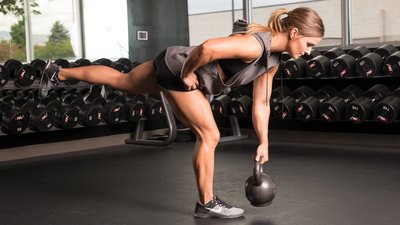Glutes are all the rage—and not just for physique reasons. Athletes of all types are recognizing their seat of power for what it is, and moving it from the bottom of their training priorities to near the top—where it belongs!
Making your glute training program more well-rounded (pun intended) and effective goes beyond just doing squats, deadlifts, hip thrusts, and band shuffles. Those are great glute exercises, but there's already an abundance of info on them out there.
Use these seven glute training tips to get more out of your workouts and add more quality mass to your ass!
1. Add a Lean to Your Single-Leg RDLs
Here's a unique single-leg Romanian deadlift variation that I developed that uses a body lean to hit the glutes in two ways.
Just so you're clear on how to properly set up and perform this exercise, here's a detailed description on how to do it from my new book, "Your Workout PERFECTED."
Place one end of a barbell in a corner on your right side. Stand parallel to the barbell in a split stance, with your right foot behind your left. Keep your right heel off the ground. Position the middle of your left foot so it's underneath the weighted end of the barbell.
Keeping your back straight, hinge at your hips and bend forward toward the floor; keep your knees bent at a 15-20-degree angle. As you hinge forward, keep most of your weight on your left leg and drive your hips backward. Do not allow your back to round out. Grab the end of the barbell with your right hand and keep your thumbs on the top.
Keeping your back straight, drive your hips toward the barbell as you lift the barbell up and stand tall without overextending your lower back. As you lift the barbell up by pressing your left foot into the ground, simultaneously press yourself toward the anchor point of the barbell by leaning toward your right side so your body is at a slight angle at the top of each rep. Be sure to drive your hips toward the anchor point of the barbell and don't just lean with your shoulders. Reverse the motion and slowly lower the barbell back down to the starting position. Keep the barbell close to you throughout. Perform all the reps on the same side before switching sides.
2. Finish SLDLs With Extra Hip Drive
As I said in my article "6 Grittiest Backside Exercises You're Not Doing," performing single-leg RDLs with a dumbbell loads the glutes more in the bottom range of the exercise, when your torso is closer to parallel to the floor, but not much when your torso is upright. However, by driving your hips forward against the dumbbell in the specific way I demonstrate in this video allows you to bring in more glute involvement to the top of each rep.
Play close attention to how this is done because doing it correctly brings in more glutes, but doing it wrong will just use your lower back instead. Think hip extension, not lumbar extension. There's a big difference!
3. Do "Glute-Destroyer" Lunges
If you want to maximize glute recruitment when doing lunges, there are three things you need to do:
- Lean your torso forward at roughly at 45-degree angle, which increases glute and hamstring recruitment over an upright stance.[1]
- Take a long stride if doing walking lunges or perform them atop an elevated platform if performing reverse lunges, which brings in more glute than a narrow or level stance.[2,3]
- Use an offset load that's heavier on the back leg side (e.g., hold a single dumbbell or two unevenly loaded dumbbells), which has been shown to recruit more glute medius than loading the front-leg side.[4]
Put them all together, and you've got what I call "the glute destroyer lunge."
The glute destroyer lunge also involves the same technique discussed above for bring in more glutes at the top of the single-leg RDL, which involves driving your hips forward against the dumbbell that you're holding in front of your thigh.
As I said in my articles "The Complete Guide to Pressing" and "The Complete Guide to Rows," not every exercise is ideally suited for every rep range. I like using the glute destroyer lunge for sets in a rep range of 8-15 reps (per leg).
4. Use a High Box for Step-Ups
If you're trying to maximize glute recruitment, use the highest height platform you can without losing your technique.
Why? For one, research shows higher platform heights result in higher glute muscle activity.[5] But as a coach, I've also seen firsthand that this technique prevents cheating and tightens up form.
A couple of important cues:
- Switch legs on the ground, not on top of the bench. It's simply easier to count and track than doing it on top of the step.
- Lean forward slightly as you step up, raising your back heel off the ground so that the shoulders, hips, and rear leg form a straight line at roughly 45 degrees to the floor.
This forces you to move smoothly, so you don't jerk your torso forward to complete each rep. You'll feel the difference immediately.
5. Change Your Front Leg Position on Leg Lifts
The single-leg lift while on all fours is a staple of high-rep glute training. The big problem with this exercise is it's easy to hyperextend your lumbar spine.
This version I developed, which I call the super-dog leg lift, offers similar or better glute work as the traditional all-fours version, but without the risk of cheating with your lower back. The difference is all in what happens in the front leg.
Since this is a low-load exercise, I recommend doing high-rep burnout-type sets of 25-50 reps toward the end of your lower-body workouts.
6. Do Stability Ball Hip Extensions, Not "Hyperextensions"
Minimizing lower-back involvement should be your goal in all leg-lift exercises. Consider the movement commonly referred to as "stability-ball reverse hyperextensions," for instance. This is a horrible name, because makes it seem like the motion focuses on the lower back. The focus should be to create the extension motion via hip extension, which is why I use a different name.
Keeping your spine fairly stable while you perform the motion at your hip joints ensures maximum involvement from your glute and hamstring muscles instead of your lower back muscles. You can further amplify the glute activation by turning your toes outward at the top while holding your legs in a V-like stance.
7. Keep Your Toes Turned Downward on Side Leg Raises
Another glute exercise that's great for higher-rep burnout sets is side-lying leg raises, aka hip abductions. However, this movement is more of a glute medius move than a whole-glute or whole-hip exercise, and it should be performed with this in mind. The way this exercise is commonly done, where people externally rotate their toes upward in order to lift their leg as high as possible, doesn't bias the glute medius as much as other hip muscles.
Research shows that glute medius muscle activity is increased by keeping your toes parallel with the floor, or even turned downward.[6] It's a simple change, but an important one!
Make these moves staples of your lower-body training, either on their own or after you do big lifts like squats and deads. Then, don't be surprised when you start sharing the gospel of glutes to everyone in earshot. Get seriously behind this movement, and it'll get you a serious behind!
References:
- Farrokhi, S., Pollard, C. D., Souza, R. B., Chen, Y. J., Reischl, S., & Powers, C. M. (2008). Trunk position influences the kinematics, kinetics, and muscle activity of the lead lower extremity during the forward lunge exercise. Journal of Orthopaedic & Sports Physical Therapy, 38(7), 403-409.
- Schütz, P., List, R., Zemp, R., Schellenberg, F., Taylor, W. R., & Lorenzetti, S. (2014). Joint angles of the ankle, knee, and hip and loading conditions during split squats. Journal of Applied Biomechanics, 30(3), 373-380.
- Escamilla, R. F., Zheng, N., MacLeod, T. D., Edwards, W. B., Hreljac, A., Fleisig, G. S., ... & Andrews, J. R. (2008). Patellofemoral joint force and stress between a short-and long-step forward lunge. Journal of Orthopaedic & Sports Physical Therapy, 38(11), 681-690.
- Stastny, P., Lehnert, M., Zaatar, A. M., Svoboda, Z., & Xaverova, Z. (2015). Does the Dumbbell-Carrying Position Change the Muscle Activity in Split Squats and Walking Lunges?. Journal of Strength and Conditioning Research, 29(11), 3177.
- Macadam, P., Cronin, J., & Contreras, B. (2015). An examination of the gluteal muscle activity associated with dynamic hip abduction and hip external rotation exercise: a systematic review. International Journal of Sports Physical Therapy, 10(5), 573.
- McBeth, J. M., Earl-Boehm, J. E., Cobb, S. C., & Huddleston, W. E. (2012). Hip muscle activity during 3 side-lying hip-strengthening exercises in distance runners. Journal of Athletic Training, 47(1), 15-23.

